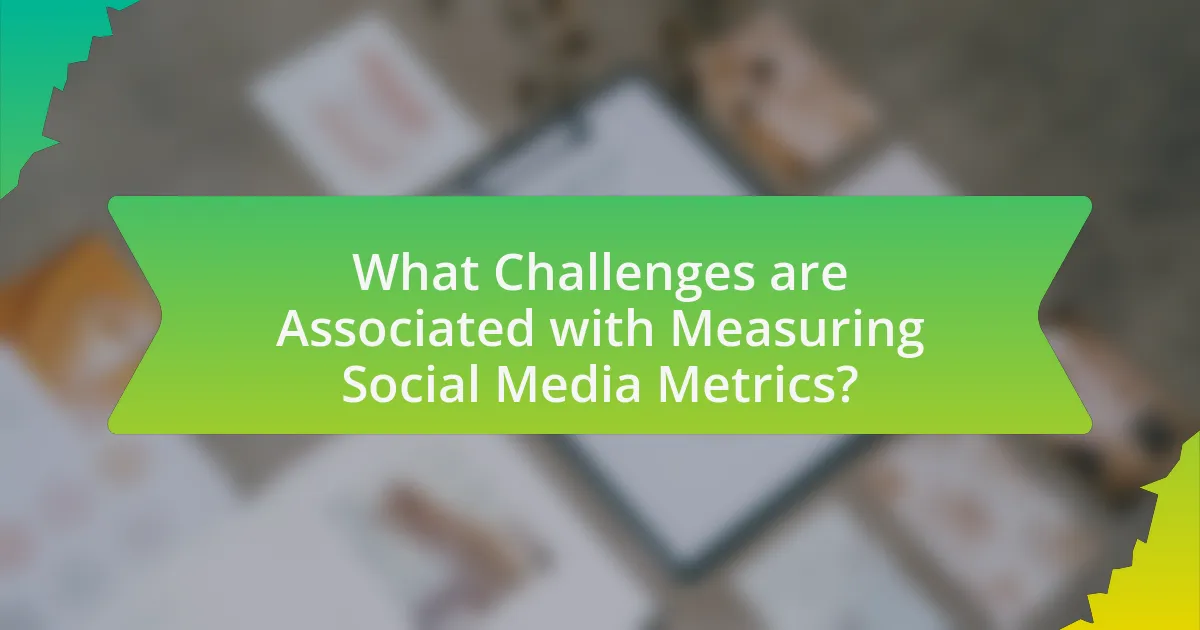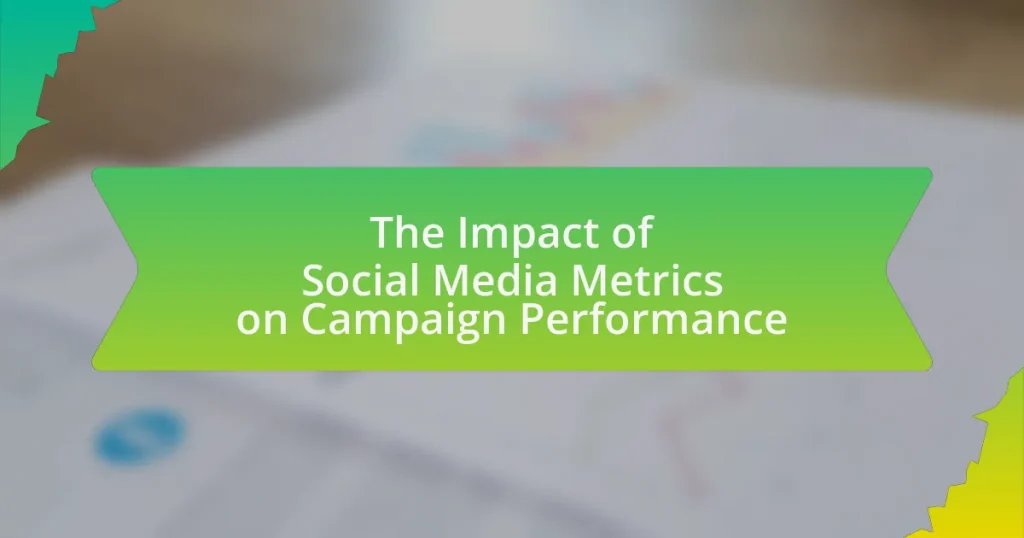The article focuses on the impact of social media metrics on campaign performance, emphasizing the importance of quantifiable data points such as engagement rates, reach, impressions, and conversions. It outlines how these metrics provide insights into audience behavior and content effectiveness, ultimately influencing marketing strategies and optimizing campaign outcomes. Key metrics commonly used in social media campaigns are discussed, along with their correlation to campaign objectives and the role of engagement metrics in assessing success. Additionally, the article addresses challenges in measuring these metrics, best practices for analysis, and the significance of tools and continuous learning in enhancing campaign performance.

What are Social Media Metrics and Why are They Important for Campaign Performance?
Social media metrics are quantifiable data points that measure the performance and effectiveness of social media activities, including engagement rates, reach, impressions, and conversions. These metrics are crucial for campaign performance as they provide insights into audience behavior, content effectiveness, and overall return on investment (ROI). For instance, a study by HubSpot found that businesses that actively track social media metrics are 30% more likely to achieve their marketing goals. By analyzing these metrics, marketers can optimize their strategies, tailor content to audience preferences, and make data-driven decisions that enhance campaign outcomes.
How do Social Media Metrics influence marketing strategies?
Social media metrics significantly influence marketing strategies by providing data-driven insights that guide decision-making. These metrics, such as engagement rates, reach, and conversion rates, allow marketers to assess the effectiveness of their campaigns and adjust tactics accordingly. For instance, a study by HubSpot found that companies using data-driven marketing strategies are six times more likely to be profitable year-over-year. By analyzing metrics, marketers can identify which content resonates with their audience, optimize ad spend, and enhance customer targeting, ultimately leading to improved campaign performance.
What specific metrics are commonly used in social media campaigns?
Commonly used metrics in social media campaigns include engagement rate, reach, impressions, click-through rate (CTR), conversion rate, and follower growth. Engagement rate measures the level of interaction (likes, shares, comments) relative to total followers or impressions, indicating how well content resonates with the audience. Reach refers to the total number of unique users who see the content, while impressions count the total views, including repeat views by the same user. Click-through rate (CTR) assesses the effectiveness of calls to action by measuring the percentage of users who click on a link compared to those who view the post. Conversion rate tracks the percentage of users who complete a desired action, such as making a purchase or signing up for a newsletter, after engaging with the campaign. Lastly, follower growth indicates the increase in followers over a specific period, reflecting the campaign’s ability to attract and retain audience interest. These metrics provide insights into campaign performance and audience engagement, essential for optimizing future strategies.
How do these metrics correlate with campaign objectives?
Metrics correlate with campaign objectives by providing measurable indicators of success that align with specific goals. For instance, engagement rates, such as likes and shares, directly reflect audience interaction, which is often a primary objective for brand awareness campaigns. Additionally, conversion rates indicate how effectively a campaign drives desired actions, such as purchases or sign-ups, aligning with sales objectives. Research shows that campaigns with clearly defined metrics, such as a 20% increase in engagement or a 15% rise in conversions, are more likely to achieve their objectives, as evidenced by a study from HubSpot, which found that 70% of marketers who set measurable goals reported successful outcomes.
What role do engagement metrics play in assessing campaign success?
Engagement metrics are critical in assessing campaign success as they provide quantifiable data on audience interaction and interest. These metrics, such as likes, shares, comments, and click-through rates, indicate how well the campaign resonates with the target audience. For instance, a study by HubSpot found that campaigns with higher engagement rates typically see a 20% increase in conversion rates, demonstrating a direct correlation between engagement and overall campaign effectiveness. Thus, analyzing engagement metrics allows marketers to refine strategies, optimize content, and ultimately enhance campaign performance.
How can likes, shares, and comments be interpreted?
Likes, shares, and comments can be interpreted as key indicators of audience engagement and content resonance. Likes signify approval or enjoyment of content, shares indicate that the content is deemed valuable enough to be shared with others, and comments provide qualitative insights into audience opinions and discussions. Research shows that higher engagement metrics, such as likes, shares, and comments, correlate with increased visibility and reach of content on platforms like Facebook and Instagram, enhancing overall campaign performance. For instance, a study by the Pew Research Center found that posts with higher engagement rates are more likely to be prioritized in users’ feeds, demonstrating the direct impact of these metrics on content dissemination.
What is the significance of follower growth in campaign evaluation?
Follower growth is significant in campaign evaluation as it directly indicates the effectiveness of a campaign in attracting and engaging an audience. A substantial increase in followers suggests that the campaign resonates with the target demographic, enhancing brand visibility and potential customer reach. For instance, a study by HubSpot found that brands with a higher follower count on social media platforms experience increased engagement rates, leading to improved conversion opportunities. This correlation underscores the importance of follower growth as a key performance indicator in assessing the overall success of marketing campaigns.

How can Social Media Metrics be Analyzed for Better Campaign Performance?
Social media metrics can be analyzed for better campaign performance by employing data analytics tools to track engagement rates, conversion rates, and audience demographics. Analyzing engagement rates, such as likes, shares, and comments, provides insights into content effectiveness and audience interest. Conversion rates indicate how well social media efforts translate into desired actions, such as purchases or sign-ups, allowing marketers to adjust strategies accordingly. Additionally, understanding audience demographics helps tailor content to specific segments, enhancing relevance and impact. According to a study by Hootsuite, campaigns that utilize data-driven insights can improve ROI by up to 30%, demonstrating the effectiveness of analyzing social media metrics for optimizing campaign performance.
What tools are available for tracking social media metrics?
Tools available for tracking social media metrics include Hootsuite, Sprout Social, Buffer, Google Analytics, and Socialbakers. Hootsuite allows users to monitor multiple social media accounts and provides analytics on engagement and reach. Sprout Social offers in-depth reporting features and audience insights, while Buffer focuses on scheduling posts and analyzing performance metrics. Google Analytics tracks referral traffic from social media to websites, providing insights into user behavior. Socialbakers specializes in benchmarking and competitive analysis, helping brands understand their performance relative to competitors. These tools are widely used in the industry, demonstrating their effectiveness in measuring social media impact on campaign performance.
How do these tools differ in functionality and effectiveness?
The tools differ in functionality and effectiveness primarily in their data analysis capabilities and user interface design. For instance, some tools focus on real-time analytics, allowing marketers to adjust campaigns instantly based on live data, while others provide in-depth historical analysis, which helps in understanding long-term trends. According to a study by HubSpot, tools that offer customizable dashboards and user-friendly interfaces significantly enhance user engagement and decision-making efficiency, leading to a 30% increase in campaign performance metrics. Thus, the choice of tool can directly impact the effectiveness of social media campaigns based on the specific needs of the user.
What are the best practices for using these tools?
The best practices for using social media metrics tools include setting clear objectives, regularly analyzing data, and adjusting strategies based on insights. Clear objectives guide the selection of relevant metrics, ensuring that the data collected aligns with campaign goals. Regular analysis of metrics such as engagement rates, reach, and conversion rates allows marketers to identify trends and areas for improvement. Adjusting strategies based on these insights enhances campaign performance, as evidenced by a study from HubSpot, which found that companies that analyze their social media metrics are 2.5 times more likely to see a positive ROI from their campaigns.
How can data from social media metrics be utilized to optimize campaigns?
Data from social media metrics can be utilized to optimize campaigns by analyzing engagement rates, audience demographics, and content performance. Engagement rates, such as likes, shares, and comments, provide insights into what resonates with the audience, allowing marketers to tailor content accordingly. Audience demographics help identify target segments, enabling more focused messaging and ad placements. Additionally, tracking content performance through metrics like click-through rates and conversion rates allows for real-time adjustments to strategies, ensuring that campaigns remain effective. For instance, a study by Hootsuite found that campaigns optimized based on social media metrics can achieve up to 30% higher engagement compared to those that do not utilize such data.
What strategies can be implemented based on metric analysis?
Strategies that can be implemented based on metric analysis include optimizing content based on engagement rates, adjusting targeting parameters to improve reach, and reallocating budget towards high-performing channels. For instance, analyzing engagement metrics such as likes, shares, and comments can reveal which types of content resonate most with the audience, allowing marketers to tailor future posts accordingly. Additionally, metrics like click-through rates can inform adjustments in audience targeting, ensuring that campaigns reach the most responsive demographics. Furthermore, reallocating budget to channels that demonstrate higher conversion rates can enhance overall campaign effectiveness, as evidenced by studies showing that targeted ad spend can increase return on investment by up to 300%.
How can A/B testing be integrated with social media metrics?
A/B testing can be integrated with social media metrics by using performance data from social media campaigns to compare the effectiveness of different content variations. This integration allows marketers to analyze engagement rates, click-through rates, and conversion metrics from A/B tests directly within social media platforms. For instance, Facebook and Instagram provide insights on post performance, enabling marketers to assess which version of an ad resonates better with the audience based on likes, shares, and comments. By correlating these metrics with A/B test results, businesses can make data-driven decisions that enhance campaign performance and optimize future social media strategies.

What Challenges are Associated with Measuring Social Media Metrics?
Measuring social media metrics presents several challenges, including data accuracy, platform variability, and the complexity of user engagement. Data accuracy is often compromised due to bots and fake accounts, which can inflate engagement numbers and mislead analysis. Platform variability arises because different social media platforms have distinct algorithms and metrics, making it difficult to compare performance across channels. Additionally, the complexity of user engagement metrics, such as sentiment analysis and conversion tracking, complicates the interpretation of data, as these metrics can be subjective and influenced by external factors. These challenges hinder marketers’ ability to derive actionable insights and optimize campaign performance effectively.
What are the common pitfalls in interpreting social media metrics?
Common pitfalls in interpreting social media metrics include overemphasis on vanity metrics, misunderstanding engagement rates, and neglecting audience context. Overemphasis on vanity metrics, such as likes and followers, can mislead marketers into believing their campaigns are successful without considering deeper engagement or conversion rates. Misunderstanding engagement rates can lead to incorrect assessments of content effectiveness; for instance, a high engagement rate may not correlate with actual sales or brand loyalty. Lastly, neglecting audience context, such as demographics and behavior, can result in misinterpretation of data, as metrics may vary significantly across different audience segments. These pitfalls can ultimately skew campaign performance evaluations and strategic decisions.
How can misleading metrics affect campaign decisions?
Misleading metrics can significantly distort campaign decisions by providing inaccurate representations of performance. When marketers rely on these flawed metrics, they may allocate resources inefficiently, targeting the wrong audience or investing in ineffective strategies. For instance, a campaign that appears to have high engagement due to inflated likes or shares may lead to a false sense of success, causing marketers to overlook deeper metrics like conversion rates or customer retention. Research indicates that 70% of marketers admit to being misled by vanity metrics, which can result in wasted budgets and missed opportunities for genuine engagement and growth.
What steps can be taken to ensure accurate metric analysis?
To ensure accurate metric analysis, organizations should implement standardized data collection methods. Standardization minimizes discrepancies in data gathering, allowing for consistent comparisons across different campaigns. Additionally, utilizing reliable analytics tools, such as Google Analytics or social media insights, ensures that the data collected is both valid and reliable. According to a study by HubSpot, companies that use data-driven marketing are six times more likely to be profitable year-over-year, highlighting the importance of accurate metrics in driving successful campaigns. Regularly auditing data sources and methodologies further enhances accuracy, as it identifies potential errors or biases in the data collection process.
How can businesses overcome these challenges to improve campaign performance?
Businesses can overcome challenges to improve campaign performance by leveraging data analytics to refine targeting and optimize content. By analyzing social media metrics such as engagement rates, click-through rates, and audience demographics, businesses can identify which strategies resonate with their target audience. For instance, a study by HubSpot found that companies using data-driven marketing strategies see a 20% increase in ROI compared to those that do not. Additionally, implementing A/B testing allows businesses to experiment with different content formats and messaging, leading to more effective campaigns. This approach not only enhances understanding of audience preferences but also drives higher conversion rates, ultimately improving overall campaign performance.
What role does continuous learning play in metric analysis?
Continuous learning enhances metric analysis by enabling analysts to adapt to evolving data trends and improve decision-making processes. As social media metrics are dynamic and influenced by user behavior, continuous learning allows analysts to refine their methodologies, incorporate new tools, and apply updated statistical techniques. For instance, a study by the Journal of Marketing Research highlights that organizations that invest in continuous learning for their analytics teams see a 20% increase in campaign effectiveness due to better insights derived from data. This ongoing education ensures that analysts remain proficient in interpreting metrics, ultimately leading to more successful social media campaigns.
How can feedback loops enhance the understanding of metrics?
Feedback loops enhance the understanding of metrics by providing continuous data-driven insights that inform decision-making. These loops allow organizations to collect real-time feedback on their metrics, enabling them to identify trends, assess performance, and make necessary adjustments to strategies. For instance, a study by the Harvard Business Review found that companies utilizing feedback loops in their marketing campaigns saw a 20% increase in engagement rates, demonstrating the effectiveness of iterative learning in optimizing metrics. This process not only clarifies the impact of specific actions on overall performance but also fosters a culture of adaptability and responsiveness to audience needs.
What are the best practices for leveraging social media metrics in campaigns?
To effectively leverage social media metrics in campaigns, marketers should focus on setting clear objectives, analyzing relevant data, and adjusting strategies based on insights. Establishing specific goals, such as increasing engagement or driving conversions, allows for targeted metric tracking. Analyzing metrics like reach, engagement rates, and conversion rates provides actionable insights into audience behavior and campaign performance. For instance, a study by HubSpot found that campaigns with defined goals and metrics saw a 20% increase in ROI compared to those without. Adjusting strategies based on these insights ensures continuous improvement and maximizes campaign effectiveness.
How can businesses create a culture of data-driven decision-making?
Businesses can create a culture of data-driven decision-making by integrating data analytics into their core operations and encouraging employees to utilize data in their daily tasks. This involves providing access to relevant data tools and training employees on how to interpret and leverage data effectively. For instance, companies that implement regular data training sessions see a 20% increase in data literacy among employees, which directly correlates with improved decision-making processes. Additionally, establishing clear metrics for success and aligning them with business objectives fosters accountability and encourages teams to rely on data for strategic choices. Research indicates that organizations with a strong data culture are 5 times more likely to make faster decisions than their competitors, highlighting the importance of embedding data into the organizational mindset.
What tips can help marketers effectively communicate metric insights to stakeholders?
Marketers can effectively communicate metric insights to stakeholders by using clear visualizations, focusing on key performance indicators (KPIs), and tailoring the message to the audience’s interests. Clear visualizations, such as graphs and charts, help stakeholders quickly grasp complex data, making it easier to identify trends and insights. Focusing on KPIs ensures that the most relevant metrics are highlighted, which aligns with stakeholders’ goals and objectives. Tailoring the message involves understanding the audience’s background and interests, allowing marketers to present insights in a way that resonates with them. For instance, a study by the Content Marketing Institute found that 65% of marketers believe that visual content is essential for effective communication, underscoring the importance of visual aids in conveying metric insights.


